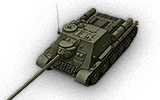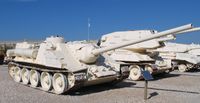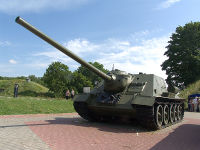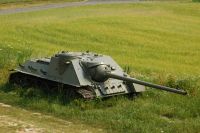SU-100
SU-100 (Stock)
| 908900 價格 |
| 580 血量 |
| 31.48 / 37.4 公斤重量 |
- 車長
| 75/45/45 前/側/後,毫米車身裝甲 |
| 0/0/0 前/側/後,毫米砲塔裝甲 |
| 500 匹馬力引擎功率 |
| 50 公里/小時最高時速 |
| 34 度/秒迴轉速度 |
| 160 標準砲彈殺傷力 |
| 120 毫米標準砲彈穿透力 |
| 4.4 完全裝填的時間 |
| 44 度/秒砲塔迴轉速度 |
| 350 公尺可視範圍 |
| 325 公尺訊號範圍 |

The SU-100 is a Soviet Tier VI Tank Destroyer.
Like the SU-85, the SU-100 was based off the T-34 chassis, and was an improvement on the SU-85 design itself. It mounted the much more powerful 100mm D-10S gun, which could handle almost all armor thrown at it from considerable combat ranges. Mounting arguably the most powerful tank destroyer gun in WWII, it like the Jagdpanther entered late and thus had little impact on the war. Production began in September 1944, and continued being produced into the 1950's by other countries.
It is very similar to the SU-85 in most stats, such as speed, mobility, and camouflage. However it has much improved view range and of course guns, making it a far more devastating vehicle than it's Tier V counterpart. Thanks to the 100mm D-10S and 122mm D-25S, the SU-100 is one of the strongest tank destroyers in the game, relative to it's battle tier.
Compatible Equipment
Compatible Consumables
Player Opinion
Pros and Cons
Pros:
- Great gun in the 100mm D-10S; excellent penetration, great alpha DMG, good RoF, decent aim time, acceptable accuracy
- Good gun in the 122mm D-25S; excellent penetration, absurd alpha DMG, acceptable accuracy, poor aim time, poor RoF
- Great speed and mobility
- Decent armor for a TD; Tier IV and some Tier V will struggle frontally against it
Cons:
- Low Hit Points
- High ammo cost on 122mm D-25S (1025AP/608HE)
- Weaker ammo rack than most other Tier VI TD's
- Average view range for Tier VI TD
Performance
The SU-100 is a mobile and hard hitting tank destroyer, but with low Hit Points and unimpressive armor. As such, the tank works well at playing the role of sniper in early and mid game, before transitioning to an aggressive tank destroyer in the latter part of the battle. Early on use the excellent camouflage and conceal yourself while the forward tanks light up targets for you. As the battle progresses start making your way up closer to the front, where your lack of excellent accuracy becomes less of an issue. Don't be afraid to buddy up with the medium tanks in the latter battle to go hunting for stragglers and wounded enemy tanks.
The two top guns for the SU-100 are both powerful. The 100mm is the more accurate gun thanks to base accuracy and aim time, with excellent penetration at 175mm, and alpha damage equivalent to that of the Tiger tank a tier higher. It has a fast rate of fire for what it is, and has a higher DpM than the tier VII heavies. The second top gun is the 122mm, which like the one on the KV-1S, is absolutely devastating to same tier and especially lower tier vehicles. It can OHKO all tier IV tanks, most tier V, and shave off half or more hit points from any tier VI tank. It does this better than a howitzer, as it has 175mm penetration on it's AP and better base accuracy (relative to derps). There are some drawbacks though to the 122mm. First, it has a horrendous aim time for a TD at this tier. Two, it has a slow rate of fire especially when compared to other guns in this tier range. Three, the ammunition cost is expensive.
The 100mm is more flexible, where as the 122mm is more explosive. Choose accordingly based upon how you want to play the tank, and how often you are top tier.
Historical Info
The SU-100 was a Soviet tank destroyer. It was used extensively during the last year of World War II and saw service for many years afterwards with the armies of Soviet allies around the world.
Development
It was developed in 1944 as an improvement to the SU-85, built on the same chassis as the T-34-85 tank. It was designed and built at the UZTM (Russian abbreviature УЗТМ for Уральский Завод Тяжелого Машиностроения - Ural Heavy Machinery Factory, also called Uralmash) in Yekaterinburg. The SU-100 quickly proved itself to be among the best self-propelled anti-tank guns of World War II, able to penetrate 125 mm (4.9 in) of vertical armor from a range of 2,000 m (1.2 mi) and the sloped 85 mm (3.3 in) front armor of the German Panther from 1,500 m (0.93 mi).[citation needed] This was quite capable of defeating any German tank in service, for which Soviet soldiers gave it the obscene nickname "Pizdets vsemu" ("Fucking end to anything").[1] The development was conducted under supervision of L. I. Gorlitskiy, chief designer of all medium Soviet self-propelled guns. The work started in February 1944, and the first prototype of SU-100, called "Object 138", was built in March. After intensive testing with different models of the 100 mm gun, Soviet engineers approved the D-10S gun for mass production. This gun was developed in Constructors Bureau of Artillery Factory No. 9 under guidance of F. F. Petrov. After the Second World War, it was installed on T-54 and T-55 tanks and its derivatives were in service forty years after initial development. The hull of the SU-100 had major improvements over the SU-85; thickness of front the armour plate was increased from 45 to 75 mm (1.8 to 3.0 in), and the commander's workplace was made in a small sponson on the right side of the hull. Combined with the commander's cupola, this greatly improved the commander's effectiveness. For better ventilation, two ventilator units were installed instead of only one as in the SU-85. Mass production began in September 1944.
In service
The SU-100 saw extensive service during the last year of the war. It was used en masse in Hungary in March 1945, when Soviet forces defeated the German Operation Frühlingserwachen offensive at Lake Balaton. By July 1945, 2,335 SU-100s had been built. The vehicle remained in service with the Red Army well after the war: production continued in the Soviet Union until 1947 and into the 1950s in Czechoslovakia. It was withdrawn from Soviet service in 1957, but many vehicles were transferred to reserve stocks. Some exist to this day in the Russian Army holding facilities. Many Warsaw Pact countries also used the SU-100, as did Soviet allies such as Egypt, Angola, and Cuba. The SU-100 saw service in the fighting that accompanied the 1956 Suez Crisis, in which the Egyptians used SU-100s against Israel's M4 Sherman tanks. The vehicle was also utilised in the 1967 Six-Day War and the 1973 Yom Kippur War. It was modified slightly to adapt it to the sandy conditions of the Middle East, thus creating the SU-100M variant. Exported SU-100s continued in service until the 1970s, and in some countries, even later. The SU-100 remains in use by the Vietnam People's Army and the Korean People's Army Ground Force despite the age of the design. SU-100s entered service with the People's Liberation Army (PLA) of China in 1955 after Soviet forces left Dalian. The armaments in Dalian were sold to China, including 99 SU-100s, 18 IS-2 heavy tanks, 16 T-54s and 224 T-34s, with which PLA formed into the 1st Mechanised Division.
In popular culture
The crew of a World War II SU-100 and their vehicle are the heroes of the old Soviet film «На войне как на войне» Na vojne kak na vojne ("Alls fair in love and war" (literally: "In wartime its like wartime")), one of several Soviet films made about self-propelled artillery men. Veterans of the German-Soviet War found this picture quite realistic. The movie includes a Soviet tankmen song, which is popular with both Russian armoured soldiers and civilians.
Sources and External Links
| Light Tanks | |
| Medium Tanks | |
| Heavy Tanks | |
| Tank Destroyers | |
| Self-Propelled Artillery |
| USA | |
| UK | |
| Germany | |
| USSR | |
| China | |
| Japan |



